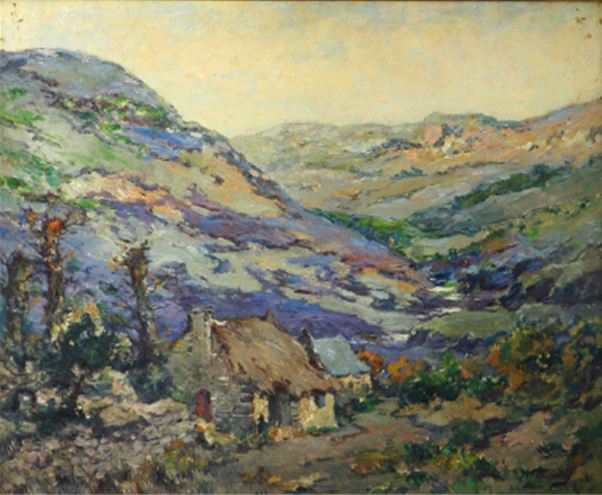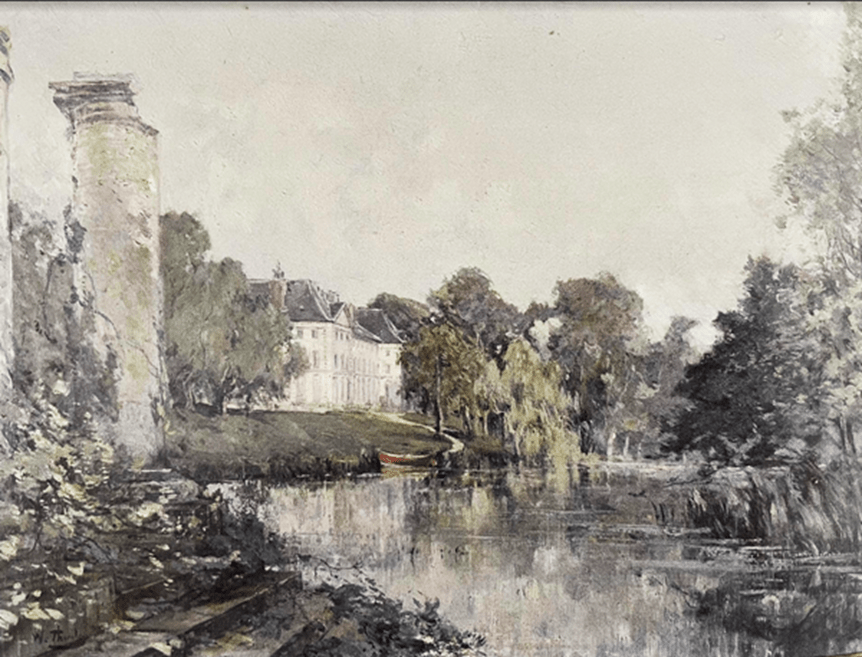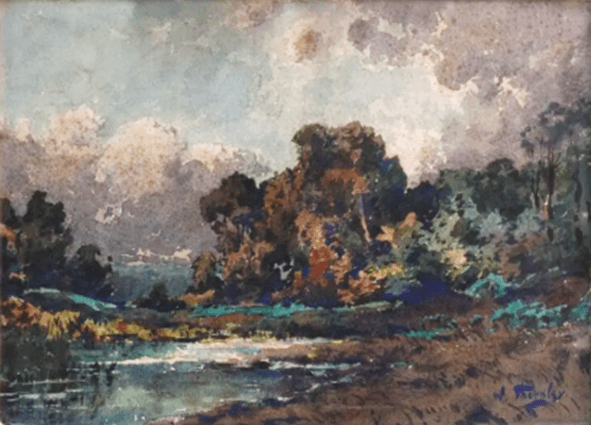Paysage dans les environs du Blavet – Huile sur toile (60x73cm) – entre 1913 et 1921
Visuel reproduit avec l’aimable autorisation de Quimper Enchères. (11, rue Marcel Paul – ZI Kerdroniou 29000 Quimper).
Cette œuvre a été présentée lors de la vente du 1er avril 2023 à Quimper. Elle a été réalisée en Bretagne (Le Blavet est un fleuve qui coule dans les départements des Côtes-d’Armor et du Morbihan et qui se jette dans l’océan Atlantique à proximité de Lorient). Le format de la signature de l’artiste permet de situer avec certitude cette composition après 1900. Pour mémoire, le Salon de Paris de 1879 marqua le début de la carrière du peintre. ll y exposa une marine: « Rade de Pornic » (3882). A cette époque, Pornic est encore attachée à la Bretagne. C’est donc dès cette période qu’il commença à réaliser ses premières œuvres en Bretagne. D’autres voyages auront lieu également en Bretagne entre 1913 et 1921 (C.f l’Echo pontoisien du 09/10/1913 et l’Echo pontoisien du 8/12/1921). C’est probablement entre ces deux dates qu’il faut situer la rélisation de ce tableau.
Le style et les couleurs, au coup de pinceau audacieux et à l’empâtement épais, utilisés ici par Thornley sont surprenants. Il lui arrivait parfois d’explorer de nouveaux horizons où s’étaient projetés, après avoir été influencés quelque temps par les impressionnistes, Cézanne, Gauguin, Guillaumet et quelques autres. En 1888, Paul Gauguin rédigea, à l’intention d’Emile Schuffenecker (1851-1934) ce conseil : ne copiez pas trop d’après nature, l’art est une abstraction, tirez -la de la nature en rêvant devant, et pensez plus à la création qu’au résultat (..)
Peut-être que ce jour là, William Thornley a suivi son conseil, en intégrant une part de subjectivité dans sa peinture et de l’audace dans ses recherches chromatiques. Pour autant, le résultat est là, même s’il ne correspond pas à ses productions habituelles. Les couleurs vives et contrastées, dont le bleu à une place essentielle, bien que pondéré ici où là par des touches de verts, de gris et d’ocres, sont disposées en aplats successifs sur la toile. Le ciel est secondaire dans cette composition. En avant plan, une chaumière, à la découpe particulière, évoque quelque peu le style de Van Gogh (1853-1890). Un clin d’œil de William Thornley à ce grand artiste ? Il le croisa peut-être le 18 janvier 1890, alors qu’ils étaient invités, avec d’autres peintres, au Salon des XX en Belgique (*)
La lumière éclairant le fond de la vallée invite subtilement notre regard à quitter cette scène prégnante pour se perdre, tout doucement, dans le lointain.
(*) En 1883, plusieurs jeunes artistes belges se rassemblent à Bruxelles et décident de fonder le groupe des XX. Ils décident de s’opposer activement à l’Académie en exposant chaque année, lors d’un salon sans jury ni vision imposée, des œuvres issues d’une création libre, indépendante et internationale. (Les cahiers de l’IrHis » n°9 – Noémie Goldman)

This work was presented during the sale on April 1, 2023 in Quimper. It was carried out in Brittany (The Blavet is a river which flows in the departments of Côtes-d’Armor and Morbihan and which flows into the Atlantic Ocean near Lorient). The format of the artist’s signature allows us to place this composition with certainty after 1900. For the record, the Paris Salon of 1879 marked the beginning of the painter’s career. He exhibited a seascape there: “Rade de Pornic” (3882). At this time, Pornic was still attached to Brittany. It was therefore from this period that he began to create his first works in Brittany. Other trips will also take place in Brittany between 1913 and 1921 (see l’Echo pontoisien of 09/10/1913 and l’Echo pontoisien of 8/12/1921). It is probably between these two dates that the creation of this painting should be placed.
The style and colors, with bold brushwork and thick impasto, used here by Thornley are surprising. He sometimes explored new horizons where he had projected himself, after having been influenced for some time by the Impressionists, Cézanne, Gauguin, Guillaumet and a few others. In 1888, Paul Gauguin wrote this advice for Emile Schuffenecker (1851-1934): do not copy too much from nature, art is an abstraction, draw it from nature by dreaming in front of it, and think more about the creation than the result (..)
Perhaps that day, William Thornley followed his advice, integrating a part of subjectivity into his painting and audacity in his chromatic research. However, the result is there, even if it does not correspond to his usual productions. The bright and contrasting colors, including blue in an essential place, although weighted here and there by touches of green, gray and ochre, are arranged in successive flat areas on the canvas. The sky is secondary in this composition. In the foreground, a cottage, with its particular cutout, somewhat evokes the style of Van Gogh (1853-1890). A nod from William Thornley to this great artist? He perhaps met him on January 18, 1890, when they were invited, with other painters, to the Salon des XX in Belgium (*)
The light illuminating the bottom of the valley subtly invites our gaze to leave this significant scene to lose itself, very gently, in the distance.
(*) In 1883, several young Belgian artists gathered in Brussels and decided to found the XX group. They decided to actively oppose the Academy by exhibiting each year, at a show without a jury or imposed vision, works resulting from free, independent and international creation. (The IrHis notebooks » n°9 – Noémie Goldman)



